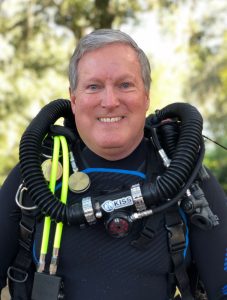Douglas Ebersole, MD is an interventional cardiologist at the Watson Clinic in Lakeland, Florida and the Director of the Structural Heart Program at Lakeland Regional Health. Diving since 1974, he is also an avid recreational, technical, rebreather, and cave diver. He is also an active recreational, technical, rebreather, and cave diving instructor. With thousands of hours on a variety of rebreathers, Doug is a strong proponent of using checklists in diving – especially rebreather diving.
How and why do you use checklists?
When not diving, I work as an interventional cardiologist which means I make my living doing procedures in the cardiac catheterization lab and in the operating room. Despite doing these procedures for over 35 years, I use a checklist before each and every one. In medicine, we call these “stop timeouts”. They range from the very short and straightforward ones used for cardiac catheterizations where we document that we have the right patient undergoing the right procedure from the right approach with the right physician to much more detailed “stop timeouts” for percutaneous aortic valve replacements where we do the above as well as documenting we have all of the emergency equipment needed should things go sideways and who is responsible for each item and each stop of the emergency procedure. After having done thousands of procedures over decades, do I think I NEED to do these time outs? My gut says no. However, my brain realizes that no matter how skilled and experienced I think I am, I am still human and humans make mistakes. Hence, I do a “stop timeout” before EVERY procedure.
In my other world, I’ve been diving rebreathers for over 18 years and have always used the same checklist approach to my rebreather diving. I am certified on and have owned many different rebreathers over the years. For each of these, I have a laminated “build” checklist in the container where I keep the rebreather. Despite thousands of rebreather dives, I use these checklists every single time I put a rebreather together.
In addition to these “build” checklists, I use two additional checklists in my rebreather diving. The first of these two was given to me by JJ-CCR instructor trainer David Thompson during my JJ-CCR instructor course. As I usually put my rebreather together the night before diving, this checklist is to make sure nothing happened overnight and that the rebreather is still working correctly on the day of the dive. The acronym is APE. The “A” is for “ambient” and refers to doing a positive and negative check. The “P” is for “pressurized” and refers to turning on all of the gases to pressurize the system and then check pressures and make sure all of the buttons work. Finally, the “E” stands for “electronics” and refers to the computer/handset. This means checking the gases are set correctly, checking battery status, checking oxygen sensor millivolts, and calibrating the sensors.
My final checklist is the one I always use before entering the water. It is another mental checklist. This one is ABCDE. “A” is for “air” and refers to verifying all gases are turned on.
“B” is for bailout and buoyancy and refers to making sure my bailout is reachable and is functional as well as making sure the wing (and drysuit) inflator is attached and functional. “C” is for computer and refers to making sure the handset is on the wrist and is set correctly as well as checking the HUD/NERD and offboard backup computer if applicable. “D” is for display and refers to making sure your loop is breathable. “E” is for “equipment” and refers to additional equipment needed for the specific dive. For a simple drift dive off West Palm Beach this may be an SMB and a reel. For a cave dive this may be more complex. For cave diving equipment, I use yet another checklist. “Go Slow. Be Real Calm, OK?”
Go – G is for gas. Gas turn pressures.
Slow – S is for sorb. Sorb turn pressure.
Be – B is for bubble check.
Real – R is for reels – primary, safety, and jump reels.
Calm –
C is for cookies.
A is for arrows.
L is for lights – primary and at least two backups.
M is for back up mask.
OK – K is for “knives” and refers to having two cutting devices.
As my students will tell you, I am truly a checklist fanatic. Every dive has at least three checklists – with a fourth for cave dives.
- A unit specific written and laminated “build” checklist
- A mental checklist the day of diving (APE)
- Ambient
- Pressurized
- Electronics
- A mental “jump” checklist (ABCDE)
- Air
- Bailout/Buoyancy
- Computer
- Display
- Equipment
- For cave diving, one more checklist (Go Slow. Be Real Calm, Ok?)
- Gas turn pressure
- Sorb turn time
- Bubble check
- Reels
- Cookies
- Arrows
- Lights
- Mask (backup mask)
- Knives (cutting devices)
Be safe, everyone. And use your checklists!!!

